|
|
|

Vintjärn, the village where Rolf grew up, is the central point in our lives and the place to which we always have returned. Our house, a log cabin from around 1870, was for a long time our summer recluse away from town. Now our permanent residence, far away from main roads, in an environment dominated mostly by dark pine forest mixed with some deciduous trees. Among the everyday chores are pumping water from our well and chopping wood for stove and fireplaces. Apart from the 2-3 months of midwinter, with deep snow and an arctic wind sweeping through the forest, life on the whole is simple and without worries.
On a spring day more than 260
years ago Olof Andersson, a Finlander living at Gräsbackstorp near Svartnäs
came wandering through the uninhabited wilderness on his way to the church
at Svärdsjö. We imagine that at some point he picked up a stone, weighed it
in his hand and found it surprisingly heavy.
This is what he tells us in a letter written and dated 29 April 1726
(excerpt)
“In the year 1725, on the last Great Day of Prayer, I found a stone of iron
ore at Vintjärns Kölen and took it down to Bäckagården in Böle By. I there
told Påhl Andersson from Lilla Björnmossen about my find, the place where I
had found it, and showed him a stone as proof.”
The long and rather detailed letter, signed by a certain Laurent Wåhlberg at
Wij Bruks Sätesgård, who by a sworn Olof Andersson was told the story of the
find. It has been said that Olof Andersson sold his discovery for a roll of
tobacco, which he regarded as a fair price.
The find of Olof Andersson resulted in mining operations in Vintjärn. At the start, it was on a modest scale and privately owned, in time it grew in volume and Stora Kopparberg took over the management. A shaft head was erected and soon became the center of village life. The shaft head is still in place, but today only as a reminder of the past.
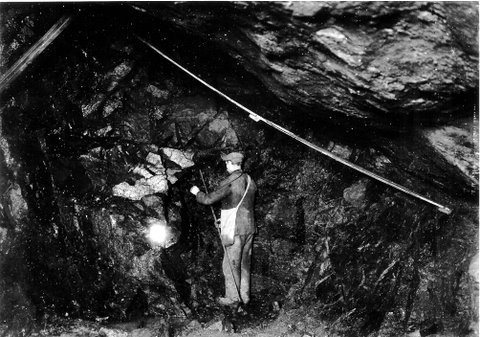
The very first extraction of ironstone was done through surface quarrying. In order to follow the iron ore, it eventually became necessary to go deeper. Working underground increased the risk of severe accidents such as cave-ins and falls from slippery ladders. As shown in the picture, protective gear was still quite primitive well into the 20th Century.
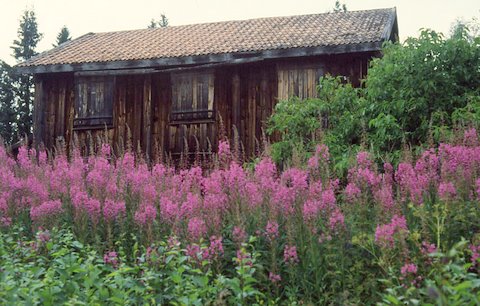
The men who by horse and sled transported the ironstone to the foundries did perhaps a less dangerous, but still strenuous and heavy work. Solgruvstugan, the oldest building in Vintjärn, was for many years used as night quarters for tired horse drivers.
Åg was the nearest foundry. In picturesque surroundings the building still stands, and has aged with a certain charm. Nowadays Åg is a practically deserted village, except for a few summer residences; only one or two houses are lived in year round.

For several generations the mine in Vintjärn kept people in the area. In the middle of nowhere, the village came alive. In my youth, there was a school, two general stores, functioning bus service – and a soccer team. However, in 1979 everything ended. Mining operations ceased due to poor returns and people moved elsewhere. The school and the stores were closed, buses and other services ended and the soccer team was scattered. Around sixty people are still year round residents, but many houses are empty, or used only in summer.
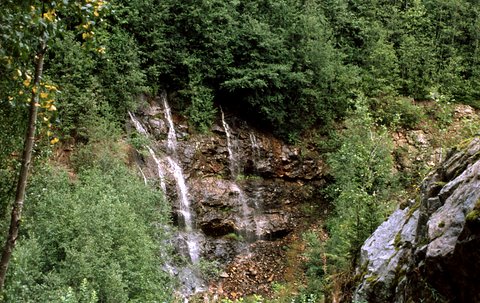
Along with depopulation and dismantling, silence slowly descended upon the village. Left was an increasingly lush environment, many desolate houses and a number of mine shafts. As vegetation spread, those shafts grew over and became shelters for fox, badger and raccoon dog. Many years ago roach was stocked in a couple of water-filled shafts. They thrived in the cool water and were caught when needed as baitfish for winter fishing.
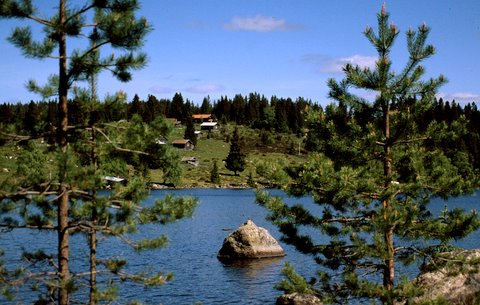
Before the days of mining operations, the forests around Vintjärn and Svartnäs were not untouched by human activities. Farmers from Linghed and Böle drove their cattle to pasture on higher grounds, often a hike of around 15 kilometers on rough paths through the woods. Many small “fäbodar” were established, where milkmaids prepared butter and cheeses. One of these, Nysjöns fäbod, still a living fäbod, is beautifully situated overlooking Nysjön, a lake teeming with fish.
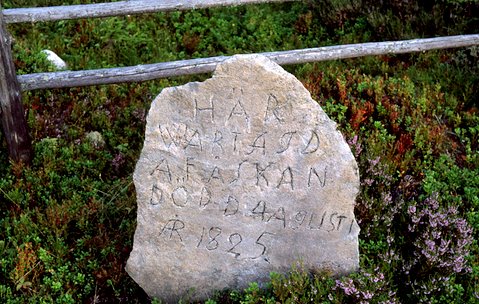
HERE WAS AJD BY LIGHTNING DEAD 4 AUGUST YEAR 1835
Anna Jansdotter (AJD) was born on September 3, 1810. In late summer 1825, only 15 years old, she was killed by lightning at Finnköln, where she worked as milkmaid for Erikjöns in Linghed. Who carved her date of death in stone is unknown. A fiancé, or a relative?

At the beginning of the 17th Century eastern peoples, mainly Finns migrated to the region. They spoke a Finno-Ugric language, originating from Western Siberia and Hungary. They felt quite at home in the vast wilderness, built small log cabins, used the slash-and-burn method, trapped fowl, built rafts and laid nets in the lakes. Remnants are still found from this period, and well into the 20th Century, you could hear Finnish spoken.
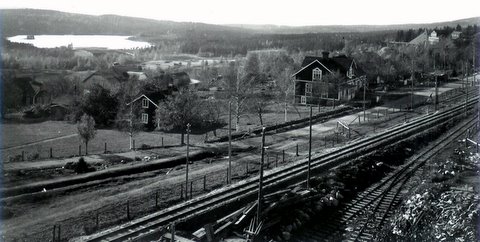
The lower part of the village the way it looked when I grew up. The building on the far right is the enrichment works, where the iron ore was ground into fine iron silt. On windy days, black dust blew in over the village, and housewives would hurry to bring in the laundry from the wash line. At the left corner of the picture, there is a small stream with plenty of fine trout. With my keen interest in fishing, I never lacked for activity in my free time.
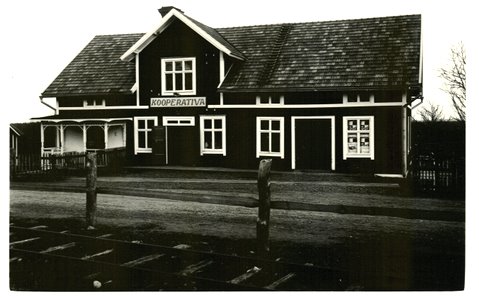
A cooperative country store covered the daily needs for the people in the village. Here you could buy everything from herring to nails, pipe tobacco, sewing thread and magazines. The yearly Christmas party arranged by the cooperative was a popular event with movies, dance and the distribution of gifts for the youngest. As the population diminished, it was hard to keep the store alive. After 99 years of business, the store closed for good, greatly missed by all villagers.
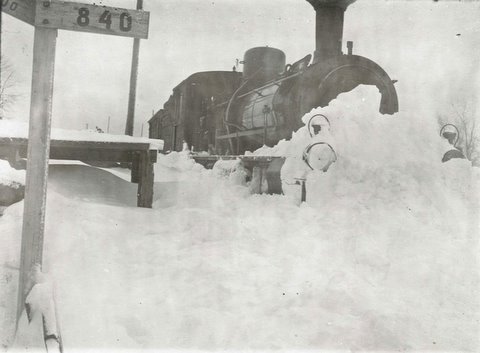
Clear into end of the sixties, a railway crossed the village. It was mainly used for transportation of timber and iron ore to the coast, where it was transferred to ships for export abroad. In summer, this transport was usually without problems, except that embers from the steam locomotive’s chimney at times caused small forest fires. In winter, it was quite another story, when the snow lay deep and the train could be stuck in the snowdrifts. The rails were torn up in 1968 and slowly nature began to reclaim the land.

The café was for many years a gathering place for both young and old. Here the first secret cigarette was enjoyed, teenage romances flourished, and here they served fresh cinnamon rolls and innumerable cups of coffee. Paying guests from other parts of the country enjoyed clean air, untouched forest, green pastures and excellent skiing in winter.
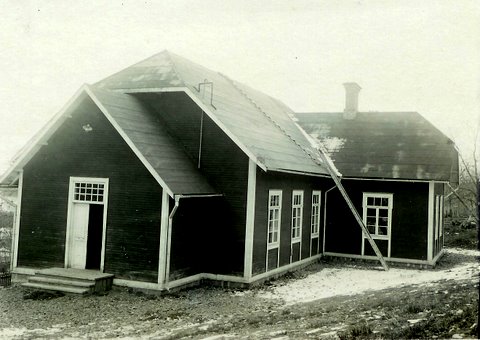
Knutte Björk , accordion player from Falun, told of the numerous evenings in Vintjärns Folkets Hus, the local community center. Young people from the whole region gathered there eager to dance. Folk dances, waltz, tango, foxtrot and sometimes, pure swing were part of the repertoire. Nowadays we use the building for local meetings of the village council, bingo, birthday and Christmas parties and exhibitions.

Some of the pictures from Vintjärn have a certain patina and
this old school photo done by a traveling photographer is no exception.
Represented in the picture are all the grades in my school. Faces change
over time and, definitely, the fashion too. Somewhere in this group of
youngsters, you could find me. Where? Well, that is really of no interest.
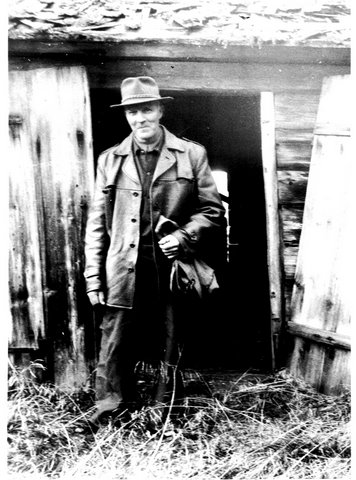 |
ElovVestgren, a self-taught artist from Vintjärn , is credited for substantial documentation of the village from 1920 and four decades on. On panniers and masonite he recorded buildings and milieus that, if they still exist, have changed over the years. In summer, Elov put up his easel outdoors, and even though mosquitoes made his skin burn, he painted with honesty and utmost care what his eye saw. |
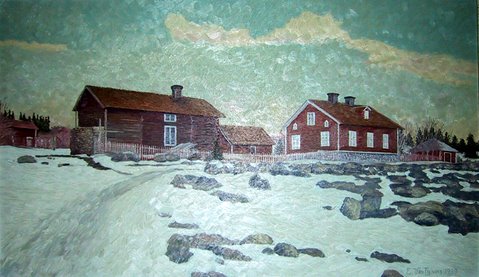
This particular milieu exists only on Vestgren’s painting from 1939. Evidently, the picture was created in early spring when the snow had started to melt around the rocks in the foreground. The biggest house, where Elof himself lived during a period, was commonly called “Värmland”, since it was built by carpenters from the province of Värmland at the beginning of the 20th Century.
Another of Vestgren’s paintings shows the view from a hill north of the village. The meadow where Elof had set up his easel was a popular place for outings and pick-nicks. In the back of this picture, you get a view of Ågsjön under a cloudy sky. There is not a trace left of the meadow and the barn. The once open landscape, is today spoiled by a tall forest.
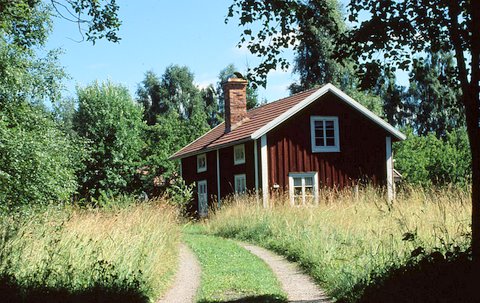
In spite of everything, my old village is still alive, today more beautiful than during the mining epoch. Older houses have gracefully integrated with the lush environment, while others are still standing like worn monuments of bygone days. The nature surrounding the village offers hiking, fishing and hunting. It also gives us that, which many lack in their lives, a sense of freedom, revival, and a constant flow of inspiration. There is no place, where I would rather live.

King Oscar II, at Lilla Björnmossen, shot the last bear in
the area in 1888. From his comfortable chair in a clearing, the King fired
his gun and the bear fell lifeless to the ground. It has been told that the
King shot up from his chair dancing around cheering: “The bear is dead, the
bear is dead!!” Bear, along with wolf and lynx, which were almost extinct
during 1860-70, once again inhabit our forests.

There are two larger lakes in the area. One of them is Hyn, shaped like a four-pointed star, with clear water and beautifully polished stones strewn along the banks. Tie-downs anchored to cliffs are reminders of the time when the floating of timber was the common way of transportation. Today, only the wind fills the wilderness with sound. A canoe trip in pleasant weather coffee and sandwiches in your backpack is not only a journey in present time, it is also gives perspective into the past.

Ågsjön, the other big lake, has a
completely different character with shallow and weed infested bays. A ridge
of recessional moraines from the ice age runs across the lake and here and
there appears as rounded fir clad islands. The lake, considered rather
difficult to fish, holds trout as well as pike, whitefish and perch.

The yellow mail delivery car is a welcome sight on our roads. In roaring snowstorms, or pouring rain, it always turns up faithfully with letters, packages and postal orders. It is a well functioning service that simplifies life in thinly populated areas. Great changes have taken place in village life during the last decades. The car in the picture is a symbolic link between an epoch gone by, and the present, with its new values and another way of living.
